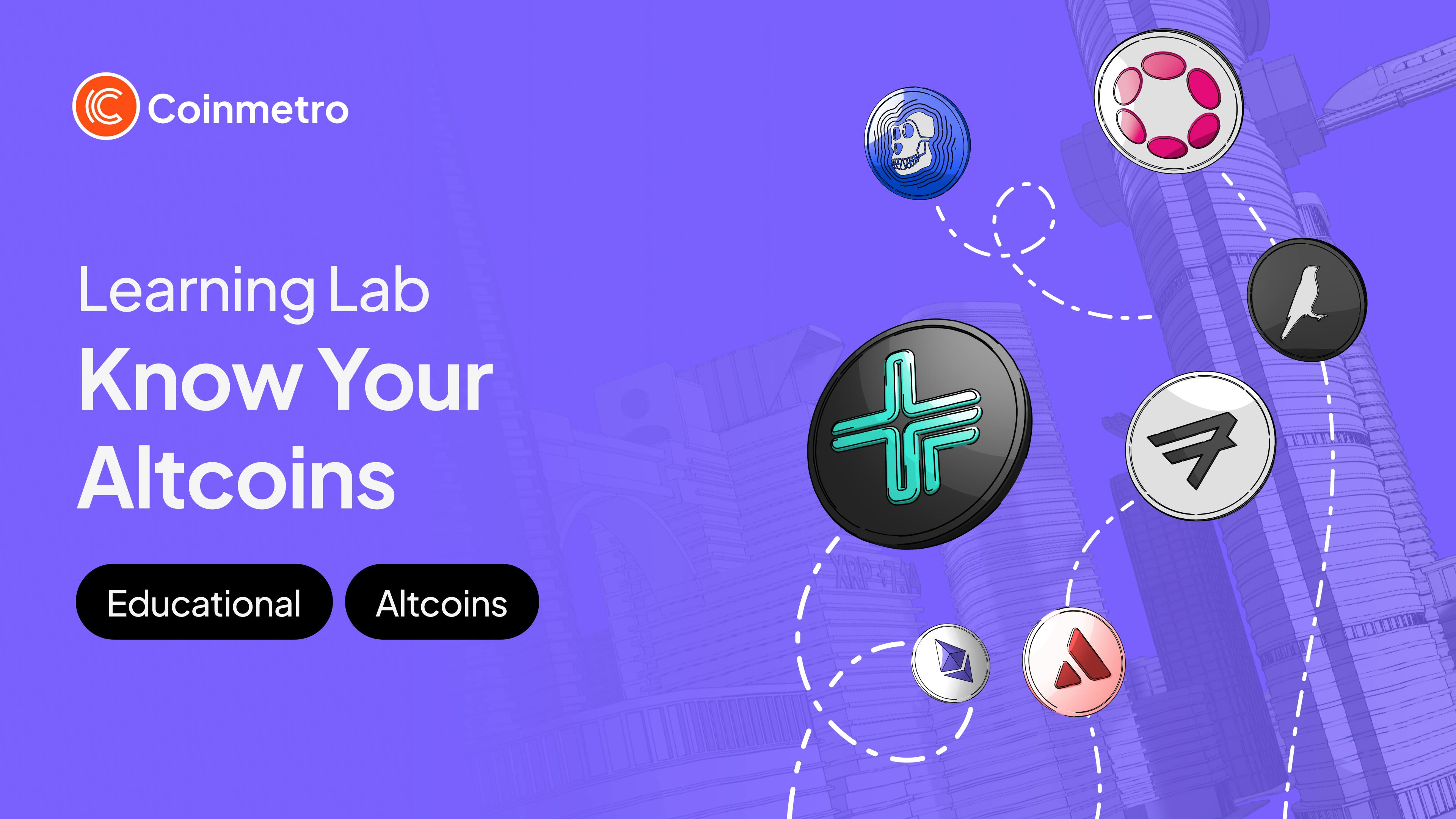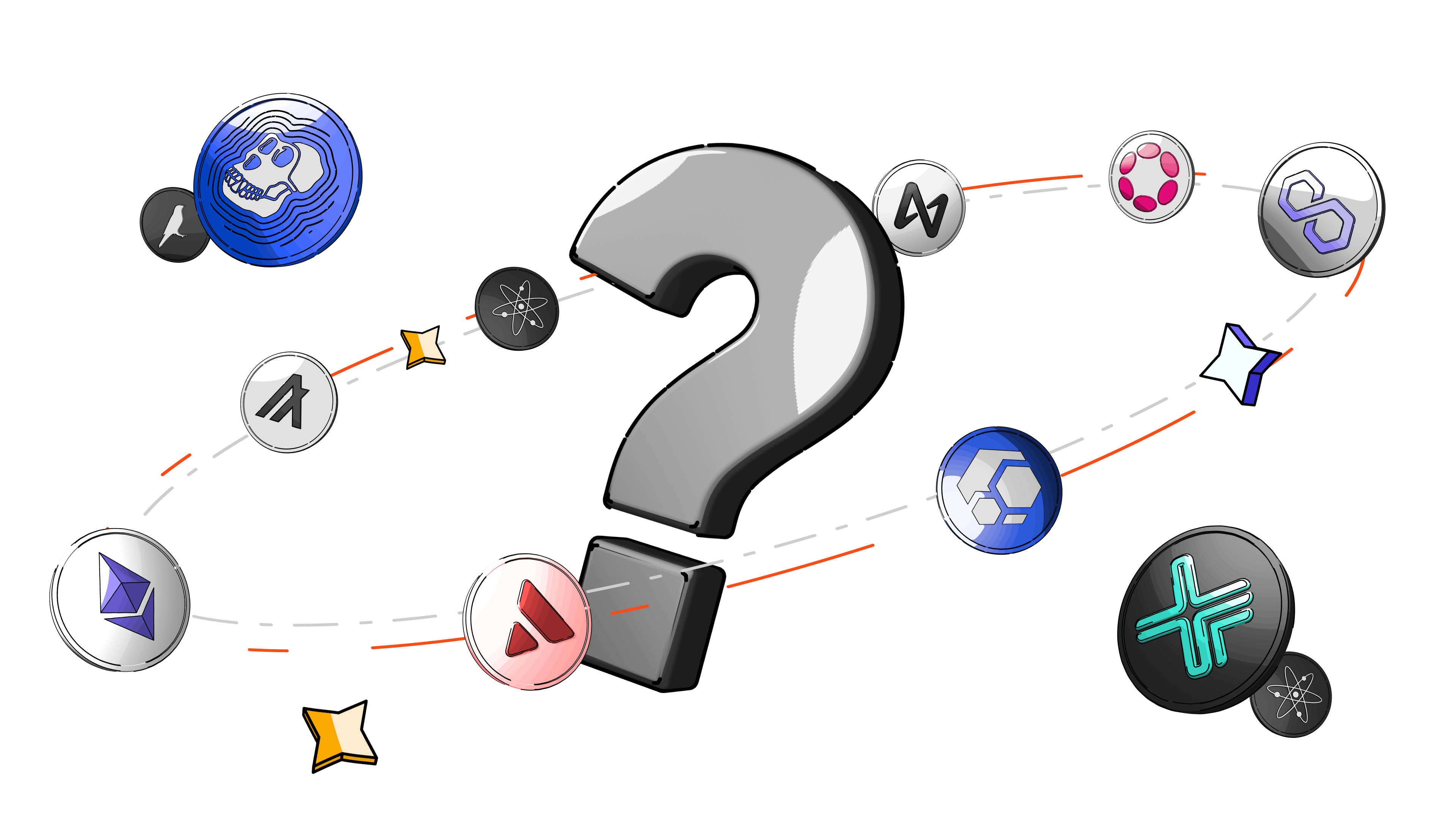What Are Altcoins? Exploring Alternative Cryptocurrencies
December 5, 2025

by Kamil S
December 5, 2025
Altcoins encompass a vast collection of digital currencies that have emerged alongside Bitcoin, the pioneering cryptocurrency. While altcoins share the foundation of blockchain technology, they are not merely alternatives to Bitcoin. Instead, they represent a dynamic ecosystem of cryptocurrencies, each with its own distinct characteristics and objectives. Unlike Bitcoin, which operates on its own blockchain, some of the best altcoins leverage various blockchain technologies and protocols to offer unique features and functionalities.
The origin of altcoins can be traced back to the desire for enhanced scalability, improved privacy, and specialized use cases beyond what Bitcoin could offer. Bitcoin's success paved the way for developers and entrepreneurs to experiment with new blockchain-based solutions, leading to the birth of altcoins. Since then, altcoins have evolved into a thriving ecosystem, with thousands of different cryptocurrencies catering to diverse needs, industries, and preferences.
Altcoins were developed to address certain limitations of Bitcoin and to explore new possibilities in the world of decentralized finance. Here are some key reasons why altcoins emerged:
Enhanced Functionality: Some of the best altcoins often introduce innovative features and technologies going beyond Bitcoin's capabilities. These features may include faster transaction speeds, improved privacy measures, advanced smart contract functionalities, or compatibility with specific industries.
Specialized Use Cases: Many altcoins are designed to serve niche industries or specific use cases. For instance, some examples of altcoins focus on decentralized file storage, gaming, supply chain management, or identity verification. By catering to these specialized areas, altcoins aim to provide tailored solutions for various sectors.
Competition and Innovation: Altcoins foster healthy competition and drive innovation within the cryptocurrency space. Developers and teams constantly seek to create unique altcoins offering novel features, improved performance, or alternative consensus mechanisms. This competition drives advancements in blockchain technology as a whole.
Investment Opportunities: Altcoins provide investors with an opportunity to diversify their cryptocurrency portfolios. As the crypto market expands, altcoins offer a range of investment options beyond Bitcoin. Investors can potentially benefit from the growth and adoption of specific altcoins that align with their investment strategies.
The altcoin market is characterized by its vast scale and extraordinary variety. With thousands of altcoins in existence, each one represents a distinctive approach to blockchain technology and serves different purposes. Some popular examples of altcoins include Ethereum (ETH), Ripple (XRP), Litecoin (LTC), Cardano (ADA), Polkadot (DOT), and the Coinmetro Token (XCM), among many others.
Altcoins can be categorized into different groups based on their underlying technology, consensus mechanism, or purpose. These categories include smart contract platforms, privacy-focused coins, stablecoins, utility tokens, and more. Each category has its own set of projects, each with its own vision and objectives.
As blockchain technology advanced with decentralized finance (DeFi) and Web3 gaining momentum, altcoins emerged with specialized features and functionalities designed to cater to specific needs. In the realm of altcoins, developers harness technologies such as smart contracts, interoperability protocols, and scalability solutions, paving the way for the creation of digital assets offering seamless decentralized applications (dApps), improved transaction speeds, enhanced privacy measures, and robust governance mechanisms.
DeFi projects introduced novel concepts such as decentralized lending, yield farming, decentralized exchanges (DEXs), and liquidity pools. Altcoins specifically developed for the DeFi sector Maker (DAI), UniSwap (UNI), Aave (AAVE), aimed to provide the infrastructure and tools necessary to unlock the full potential of decentralized finance and provide users with alternative financial services and operations that traditional financial institutions could not.
Within this vibrant ecosystem, there is a list of altcoins continuing to evolve and diversify. Some altcoins focus on providing cross-chain interoperability, such as Polkadot, enabling seamless communication and asset transfers between different blockchain networks. Others aim to enhance privacy - Verge (XVG), by implementing advanced cryptographic techniques or zero-knowledge proofs.
Moreover, altcoins designed as utility tokens serve as the backbone of decentralized applications, enabling users to access and utilize specific features within these platforms. Utility tokens such as Polygon (MATIC), Chainlink (LINK), often play an integral role in incentivizing participation and driving ecosystem growth.
As new technologies continue to emerge and DeFi projects reshape the financial landscape, the list of altcoins is poised to expand further, providing even more opportunities for users to invest, trade, borrow and lend money effectively.
Altcoins operate using blockchain technology as their backbone, similar to Bitcoin. However, their underlying technology extends beyond traditional blockchains, incorporating innovative solutions to address specific needs and challenges. These solutions include smart contracts, interoperability protocols, consensus mechanisms, and scalability enhancements, among others. Altcoins harness these technologies to offer unique features, functionalities, and improvements over traditional financial systems.
Mining altcoins plays a vital role in maintaining the integrity and security of their respective blockchain networks. Miners contribute their computational power to solve complex mathematical problems, validating transactions and adding new blocks to the blockchain. This process ensures the immutability and decentralization of altcoins, preventing double-spending and providing network security. Miners are rewarded with newly minted altcoins or transaction fees, incentivizing their participation and contributing to the overall health of the network.
However, it's important to note that not all altcoins can be mined. While mining is a common process for many cryptocurrencies, there are examples of altcoins that utilize different mechanisms to distribute and validate their digital assets. Some altcoins are pre-mined, meaning that their entire supply is generated and distributed before the launch of the blockchain network. Others may use alternative consensus mechanisms like Proof-of-Stake (PoS) or Delegated Proof-of-Stake (DPoS), where validators are selected based on the amount of tokens they hold or their reputation within the network.
Altcoins transactions generally rely on a decentralized network of nodes to execute and validate transfers of digital assets. When a user initiates a transaction, it is broadcasted to the network, where miners or validators confirm its validity. Through cryptographic algorithms and consensus mechanisms specific to each altcoin, transactions are verified, recorded, and added to the blockchain. This process ensures transparency, security, and efficiency, enabling users to safely and reliably transact with altcoins.
However, not all altcoins are decentralized. Projects such as Ripple, operate on a different model compared to many other cryptocurrencies, utilizing a consensus protocol called the Ripple Protocol Consensus Algorithm (RPCA), which involves a network of trusted validators rather than a fully decentralized network of miners. This system allows for faster transaction confirmation times and scalability but deviates from the principles of decentralization underpinning many other altcoins.
The level of centralization or decentralization can vary across different altcoin projects. Some altcoins strive for a high degree of decentralization, aiming to empower individuals and create trustless networks. Others, like Ripple, adopt alternative approaches that prioritize scalability, efficiency, or specific use cases.

There is a long list of altcoins encompassing a wide range of alternative cryptocurrencies beyond Bitcoin, from utility tokens and stablecoins, to privacy-focused coins and platform-specific tokens.
While Bitcoin is the pioneering cryptocurrency, altcoins exhibit notable differences setting them apart. One key difference lies in their origin and development. Bitcoin was the first decentralized cryptocurrency, introduced in 2009 by an anonymous individual or group known as Satoshi Nakamoto. It operates on a peer-to-peer network without the need for a central authority, offering a decentralized and transparent system for financial transactions.
Altcoins, on the other hand, came into existence as alternative cryptocurrencies inspired by Bitcoin's success. While they share certain similarities, some of the best altcoins introduce variations in their underlying technology, features, and purposes. These alternative cryptocurrencies strive to address specific challenges or cater to unique use cases that may differ from Bitcoin's primary focus, such as DeFi, privacy and anonymity, smart contracts and dApp development, interoperability, and tokenization of assets.
Another notable distinction lies in their market capitalization and adoption. Bitcoin maintains the largest market capitalization among all cryptocurrencies, often regarded as the flagship digital asset. Its widespread adoption, recognition, and liquidity make it the prominent player in the cryptocurrency market. Altcoins, on the other hand, encompass a vast array of digital currencies, each with its own market capitalization and level of adoption. Some altcoins have gained significant popularity and market value, while others may have more limited recognition and liquidity.
Furthermore, altcoins often showcase diverse features and functionalities differentiating them from Bitcoin. For instance, some altcoins prioritize enhanced privacy and anonymity in transactions, implementing advanced cryptographic techniques to protect user identities. Others, such as DOT and ADA, focus on scalability solutions to overcome the limitations of Bitcoin's network, aiming to process transactions more efficiently. Additionally, altcoins may specialize in specific use cases, such as DeFi, gaming, supply chain management, or identity verification, offering tailored solutions for these industries.
Lastly, the consensus mechanisms employed by Bitcoin and altcoins can differ. Bitcoin relies on the Proof-of-Work (PoW) consensus algorithm, where miners compete to solve complex mathematical puzzles to validate transactions and secure the network. In contrast, altcoins may utilize alternative consensus mechanisms, such as PoS, DPoS mentioned previously, or other variants. These consensus mechanisms determine how network participants reach a consensus on transaction validity and maintain the blockchain's integrity.
Altcoins can be broadly categorized into several types based on their functionalities and objectives, including:
Utility Tokens: Altcoins that serve a specific purpose within a decentralized application or platform, offering access to unique features, services, or rewards, such as unlocking premium features, accessing exclusive content, or utilizing specialized tools and resources within various Web3 platforms.
Stablecoins: Cryptocurrencies are designed to maintain a stable value by pegging them to an external asset, such as a fiat currency or a commodity.
Privacy Coins: Altcoins focused on enhancing privacy and anonymity in transactions, employing advanced cryptographic techniques to protect user identities.
The categorization of altcoins is based on various criteria that consider their functionalities, underlying technology, and intended use cases:
Technology: Altcoins may utilize different blockchain platforms, consensus mechanisms, programming languages, or interoperability protocols.
Use Case: Altcoins may target specific industries or solve particular problems, such as DeFi, gaming, supply chain management, or identity verification.
Tokenomics: Altcoins may have different supply models, inflation rates, distribution mechanisms, or economic incentives designed to align with their intended purposes.
Altcoins may possess a unique valuation and market dynamics setting them apart from cryptocurrencies like Bitcoin. This will be largely subjected to the project’s technology and development, investors supporting the project, specific use cases of the assets but also the market sentiment at large.
Bitcoin Dominance: Bitcoin's dominance in the cryptocurrency market often impacts the overall sentiment and investment flow. When Bitcoin experiences significant price movements, it can influence the prices of altcoins as well.
Market Sentiment and News: Market sentiment and external news events can significantly impact altcoin prices. Positive news, such as regulatory approvals or partnerships, can drive prices higher, while negative news or market uncertainties can lead to price declines.
Technological Advancements: Technological advancements and developments within the altcoin's ecosystem can affect its price. Innovations, protocol upgrades, or the introduction of new features may drive increased investor interest and positively impact valuation.
Altcoin market cycles typically go through phases of accumulation, growth, euphoria, correction, and consolidation. During the accumulation phase, prices may remain relatively stable as investors accumulate altcoins at lower prices. The growth phase is characterized by significant price appreciation driven by increasing demand and positive market sentiment. Euphoria follows, where prices often experience rapid and unsustainable growth.
However, after the euphoria phase, a correction usually occurs, leading to a decrease in prices as market participants take profits. This correction phase is a natural part of market cycles and is often followed by a period of consolidation, where prices stabilize before the next cycle begins again.
History is filled with examples of altcoins with a dramatic rise and fall in value. For instance, during the 2021 cryptocurrency bull run, altcoins like Ethereum, Ripple, and Litecoin experienced significant price increases, reaching all-time highs. However, when the market corrected, many altcoins saw substantial price declines, leading to a sobering period for investors.
Similarly, the emergence of DeFi in 2020 brought attention to some of the best altcoins for decentralized finance like COMP and UNI. These assets saw rapid price appreciation as the DeFi sector gained popularity. However, subsequent market corrections also affected their prices.
It's essential to note that altcoin investments come with inherent risks, and price volatility is a characteristic feature of this market. By grasping the valuation and market dynamics of altcoins, considering the factors influencing their prices, understanding market cycles, and analyzing case studies, investors can navigate the altcoin market with greater confidence.
Investing in altcoins can be an exciting opportunity for individuals seeking to diversify their investment portfolios and potentially benefit from the development of various projects. However, it's important to understand the potential rewards and risks associated with altcoin investments, as well as the steps to choose and trade altcoins effectively.
Altcoin investments offer several potential rewards, including:
Greater Growth Potential: Some altcoins have the potential to experience significant price appreciation over time, especially those associated with innovative technologies or disruptive use cases. As the technology evolves and the asset gains a wider use case, its price may increase significantly in a short period of time. However, the opposite is also possible, with assets suddenly losing their valuation due to project mismanagement, competition or other factors.
Portfolio Diversification: Investing in altcoins allows diversification beyond traditional investments, such as stocks and bonds. Altcoins have the potential to perform independently of other asset classes, reducing overall portfolio risk.
Early Adoption Opportunities: Investing in promising altcoins at an early stage can provide the opportunity to participate in the growth of emerging technologies and ecosystems, potentially resulting in substantial returns as the projects mature and become widely adopted.
Altcoin investments also carry risks that investors should be aware of, including:
High Volatility: Altcoin prices can be highly volatile, experiencing rapid and substantial price fluctuations. This volatility can lead to significant gains but also expose investors to potential losses.
Regulatory and Legal Risks: Altcoins operate in a rapidly evolving regulatory landscape. Regulatory actions, legal challenges, or changes in government policies can impact the value and viability of altcoins.
When choosing altcoins for investment, it might be useful to consider the following factors:
Research and Due Diligence: Conduct thorough research on the project, including their technology, team, use case, market competition, and community support. Understanding the fundamentals and long-term viability of an altcoin is crucial.
Market Analysis: Analyze market trends, evaluate the altcoin's historical price performance, and consider factors like market demand, future adoption, trading volume, and liquidity. Technical and fundamental analysis can aid in identifying investment opportunities.
To buy and sell altcoins, follow these general steps:
Choose a Cryptocurrency Exchange: Sign up with Coinmetro today, in case you are not already registered, and gain instant access to 60+ cryptocurrencies and various crypto products that you can easily integrate.
Fund Your Account: Instantly deposit funds into your Coinmetro wallet using fiat currency or other cryptocurrencies.
Place Orders: Use the exchange's trading interface to place buy or sell orders for the desired altcoins. Set the desired price and quantity, and review the order details before confirming.
Monitor and Manage Your Investments: Regularly monitor your altcoin investments, stay updated with market news, and consider implementing risk management strategies like setting stop-loss orders or taking profits at certain price levels.
Remember, investing in altcoins involves inherent risks, and it's crucial to stay informed, exercise caution, and make considerate decisions based on your investment goals and risk tolerance.

Since their emergence, alternative cryptocurrencies have had a significant impact on the crypto ecosystem and the broader economic landscape. Understanding the role they play is crucial for comprehending the overall dynamics and evolution of the cryptocurrency market.
Innovation and Technological Advancement: Altcoins have been instrumental in driving innovation and technological advancement within the crypto ecosystem. They often introduce new concepts, features, and use cases that push the boundaries of blockchain technology. Altcoins foster healthy competition, inspiring developers to explore alternative solutions and improve existing frameworks.
Diversification of Investment Opportunities: Altcoins offer investors a diverse range of investment opportunities beyond Bitcoin. They provide access to a wide array of projects, each with its unique value proposition and potential for growth. Altcoins allow investors to participate in emerging sectors such as DeFi, NFTs, Web3 gaming, and more.
Enhanced Functionality and Specialized Use Cases: Altcoins often specialize in addressing specific challenges or catering to unique use cases that may differ from Bitcoin's primary focus. For example, altcoins like Ethereum introduced smart contract functionality, enabling the development of dApps. Altcoins like XRP focus on facilitating fast and low-cost cross-border transactions, particularly in the banking and financial sectors.
Market Liquidity and Trading Opportunities: Altcoins contribute to the overall liquidity of the cryptocurrency market. They provide additional trading pairs and enhance market depth, allowing for increased trading volume and improved price discovery. Altcoins offer traders and investors ample opportunities to participate in various markets and capitalize on price movements.
Experimentation and Proof of Concept: Altcoins serve as platforms for experimentation and proof of concept for new ideas and concepts in the crypto space. They allow developers to test innovative concepts, algorithms, and consensus mechanisms, which may later be adopted by other projects or integrated into existing cryptocurrencies.
Driving Community Engagement and Participation: Altcoins often foster vibrant and active communities around their projects. These communities engage in discussions, contribute to development, provide feedback, and support the growth of the ecosystem. Altcoin communities are vital for building awareness, driving adoption, and shaping the future direction of the respective projects.
Altcoins continue to shape and evolve the crypto ecosystem, contributing to its overall growth, innovation, and adoption. Their impact extends beyond Bitcoin, offering unique investment opportunities, driving technological advancements, and catering to diverse use cases across industries. By recognizing the role of altcoins, stakeholders can better understand the dynamics and potential of the crypto market as a whole.
What altcoins are you holding in your Coinmetro wallet?
Stay close to Coinmetro to easily buy and sell 60+ altcoins in a simple and straightforward manner. Join the Coinmetro community on Discord and Telegram to discuss altcoins news and investment opportunities with other forward-thinking traders and investors.
Should you need any help, feel free to reach out to our world-class Customer Support Team via 24/7 Live Chat or email at hello@coinmetro.com.
To become a Coinmetro user today, Sign Up now, or in case you are already registered, head over to our new Exchange and experience our premium trading platform.
Tags
Related Articles

Regulatory Sandboxes: Fostering Crypto Innovation Within Legal Frameworks
The cryptocurrency industry’s fast rise fuels an important debate. Innovation aims to transform finance, enhancing speed and access. Yet, regulators…
5m

Crypto Options Trading: Strategies and Market Insights
Cryptocurrency markets have rapidly expanded beyond simple buying and selling. One of the most significant developments has been the rise of…
6m

The Rise of Social-Fi: Blending Social Media with Decentralized Finance
In recent years, social media and finance have started to merge, creating Social-Fi. This concept blends the engagement of social platforms with…
6m

DeFi Insurance Platforms to Watch in 2024
Decentralized Finance (DeFi) insurance addresses the growing need for insurance against hacks, smart contract failures, and other DeFi-related risks.…
7m